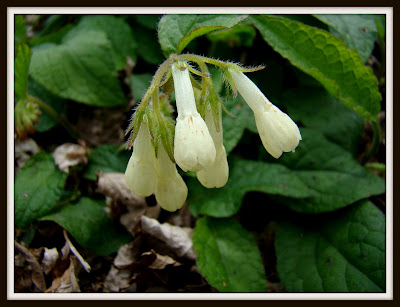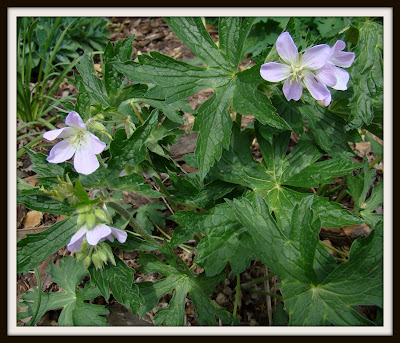These are buds and teeny-tiny blooms of Cornus sericea, commonly called red-twig dogwood. They're on one of many branches cut and used with evergreen boughs and pinecones to decorate containers last winter. Most of the cut branches are leafed out, and even rooting. Some are blooming, and they'll be left until next month when it's warm enough for summer annuals. A few will eventually be planted along an open section of our back property line. At maturity they'll be about six feet in diameter and ten feet tall, enclosing the last open border in our back yard. In the part-sun, moist-soil conditions they like, they'll be fast-growing shrubs, so it won't take very long.
Red-twig dogwoods aren't known for showy flowers. They're known for their branches. Green spring through fall, they turn brilliant red as the leaves drop in late fall, and they stay red all winter. They're fabulous against the snow, and beautiful in winter containers. The branches in our containers were cut from a dogwood in our backyard. They went straight into the pots with the bottom six inches or so poked into the soil. To give them their best chance at rooting, they were cut fresh from the shrub immediately before potting. They got no special care over the winter. The evergreen boughs insulated the soil and helped keep it moist. A few weeks ago when the weather got hot and dry, the evergreens came out and I started watering the dogwood twigs, keeping the soil evenly moist to encourage rooting.
Before the pots are filled with annuals, I'll carefully dig up the rooted branches, and transfer to them to gallon-size nursery pots. The pots will be placed in an out-of-the-way mostly-shady spot over the summer, and watered regularly. By fall they'll be ready to plant in the ground. Extras can be shared, traded at plant swaps, or donated to garden club or charity plant sales.
Senecio aureus is blooming about a month earlier than usual thanks to our extraordinarily warm March. Migrating Red Admiral butterflies were all over the blooms last week.
The Red Admirals were loving Phlox divaricata, too. Of course, when I had time in the garden with the camera, the butterflies were nowhere to be seen.
Celandine poppies, (Stylophorum diphyllum) also native wildflowers, are blooming behind the phlox, next to the kids.
I first spied Geranium maculatum about three years ago, during Spring Fling Chicago, at the Alfred Caldwell Lily Pool garden in Lincoln Park on Chicago's north side. Not long after, this one came to live in our garden.
After years of planting columbine cultivars only to have them disappear in a year or two, we added a few natives. Columbine canadensis keep coming back year after year, and will easily self-seed if you let them. If you don't want seedlings, just cut back the scapes when they're done blooming.
Dicentra cucullaria, commonly known as Dutchman's Breeches, were transplanted here from Mom's woods three springs ago. They're still settling in, and haven't bloomed yet. Maybe next year! As long as they keep coming back, I can be patient.
Podophyllum peltatum, also called Mayapples, came from Mom's woods three years ago too, where there's a large colony of them. They bloomed here for the first time last spring. This one was moved last fall to make room for a new garden path. I was thrilled to see it bloom again this spring. Mayapple blooms hide under the leafy canopy of their umbrella-like foliage. They're worth looking for!
The wildflowers pictured are all native in Illinois, and all make wonderful spring bloomers for woodland gardens. They not only survive, but even thrive in the root zones of mature silver maples in our suburban garden. They provide nectar for pollinators, and endless pleasure for us.
Gail at Clay and Limestone hosts Wildflower Wednesday the fourth Wednesday each month. Visit her blog to see what's blooming in her Tennessee garden and find links to wildflowers blooming in gardens everywhere.





















